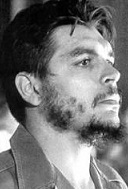|
1962 - Constant fight with the USA
Aleida 2013.11.05. 10:48

As a reply to Cuba's suspension from the Organization of the American States on 31st January, Fidel Castro issued the Second Declaration of Havana on 4th February, underlining Cuba's support for revolutionary struggle throughout the Americas. Castro became the guerrillas' champion and inspiration all over the world, while Cuba gave financial assistance, weapons and training to the Latin American guerrilla movements. Che's Guerrilla Warfare became a really popular book.
In March Cuba hosted an international chess tournament and Che took time off to watch the matches and to even play a few games. He played the Argentine Grandmaster Miguel Najdorf and the match ended in a stalemate.
Also in March the ration book (Libreta de consumo) was launched. It was the system of distribution of foodstuffs and industrial products to the population (it is still used in Cuba). When people complained that it was impossible to live on what the ration book prescribed, Che argued that his family managed well on their allowance. Then it came out that he was given two ration books - one as minister and one as comandante. When Che got to know it, he told Aleida to return one ration book immediately.
In April Che chaired the closing session of the National Council of the Central de Trabajadores de Cuba (Union of Cuban Workers). He said: "The Revolution has to be carried out at a violent pace; anyone who tires has the right to tire but not the right to call themselves part of the vanguard."
On 20th May Che's first son, Camilo was born - Che was overjoyed to have his male heir. The baby boy was named after Camilo Cienfuegos.
On 26th August Che and Emilio Aragonés left for the Soviet Union for talks about cooperation on technical, agricultural, steel and military matters. Agreements were signed at Yalta on 31st August and 2nd September. (They met Nikita Khrushchev in his summer house in Crimea where they discussed the Soviet missiles being installed in Cuba.)
Che even gave an interview in Moscow, then they arrived back in Havana on 6th September.
During October several American U2 spy planes were flying above Cuba, taking photographs of western Cuba, especially Pinar del Río where Russian missiles (directed at American cities) and installations for atomic weapons could be seen.
On 22nd October Kennedy denounced Cuba's acquisition of Soviet nuclear missiles and to inform the world of his decision to impose a naval blockade on the island - while in secret, preparing for further military actions. On 23rd October Khrushchev denounced the blockade. They played a dangerous game. (As the Americans already had missiles abroad, aimed at Soviet cities, that is why the Soviets offered some missiles to Cuba to take some advantage of the situation. The discussions were made by Raúl Castro.)
Cuba responded to the blockade by mobilising the population and putting its forces on wartime alert in preparation for the US invasion. Che commanded the forces at Pinar del Río, setting up his headquarters in a cave in the mountains, close to the missiles site in San Cristóbal.
(During this time, Che's mother came to visit her son and her grandson. She, while recovering from a recurrence of breast cancer, divorced from her husband and worked as a political activist.)
A kind of macho contest started between Castro and Kennedy while Khrushchev was playing his own game and the world was afraid of a nuclear war.
On 27th October a U2 spy plane, which violated the Cuban airspace, was shot down by a Soviet commander in the north of Oriente province.
On 28th October Khrushchev brought the crisis to an end by announcing publicly that he would remove all missiles from Cuban soil and return them to the USSR in exchange for the USA pledging not to invade Cuba. The Cuban Missile Crisis lasted 13 days.
Castro was never consulted or informed about the exchanges between Khrushchev and Kennedy. He was very angry, frustated and disappointed with the Soviets.
On 20th November the naval blockade was lifted, but all other sanctions remained.
In December Che gave an interview to the British Communist newspaper, the Daily Worker. He said that if the Soviet missiles had been manned by Cubans, they would have launched them: "Frente al agresor solo cabe la lucha a muerte." (If someone is out to get you, you have no choice but to fight to the death.) It was the proof of his deep belief in the violent solution and of his disenchantment with the Soviet Union that he didn't hide.
Though the crisis ended, the US government continued its sabotage actions in Cuba in order to weaken the revolutionary government. Castro survived several attempts on his life like exploding cigars and pens, poisoned pills and lethal chemical agents doused on his scuba-diving equipment.
Meanwhile in Cuba the government was launching a programme to promote the Cuban culture. (One of the guiding forces was Che.) The first book, distributed for free, was Don Quijote de la Mancha. New museums, art schools and theatres were created. Musicians were given salary, and there was a state support for such expensive cultural activities for the masses like ballet, theatre and classical music. Afro-Cuban cultural activities were encouraged. The intention was to counter the influence of the US mass culture. The state also took over the different branches of culture and every cultural activity had to be approved by the relevant bodies.
|

